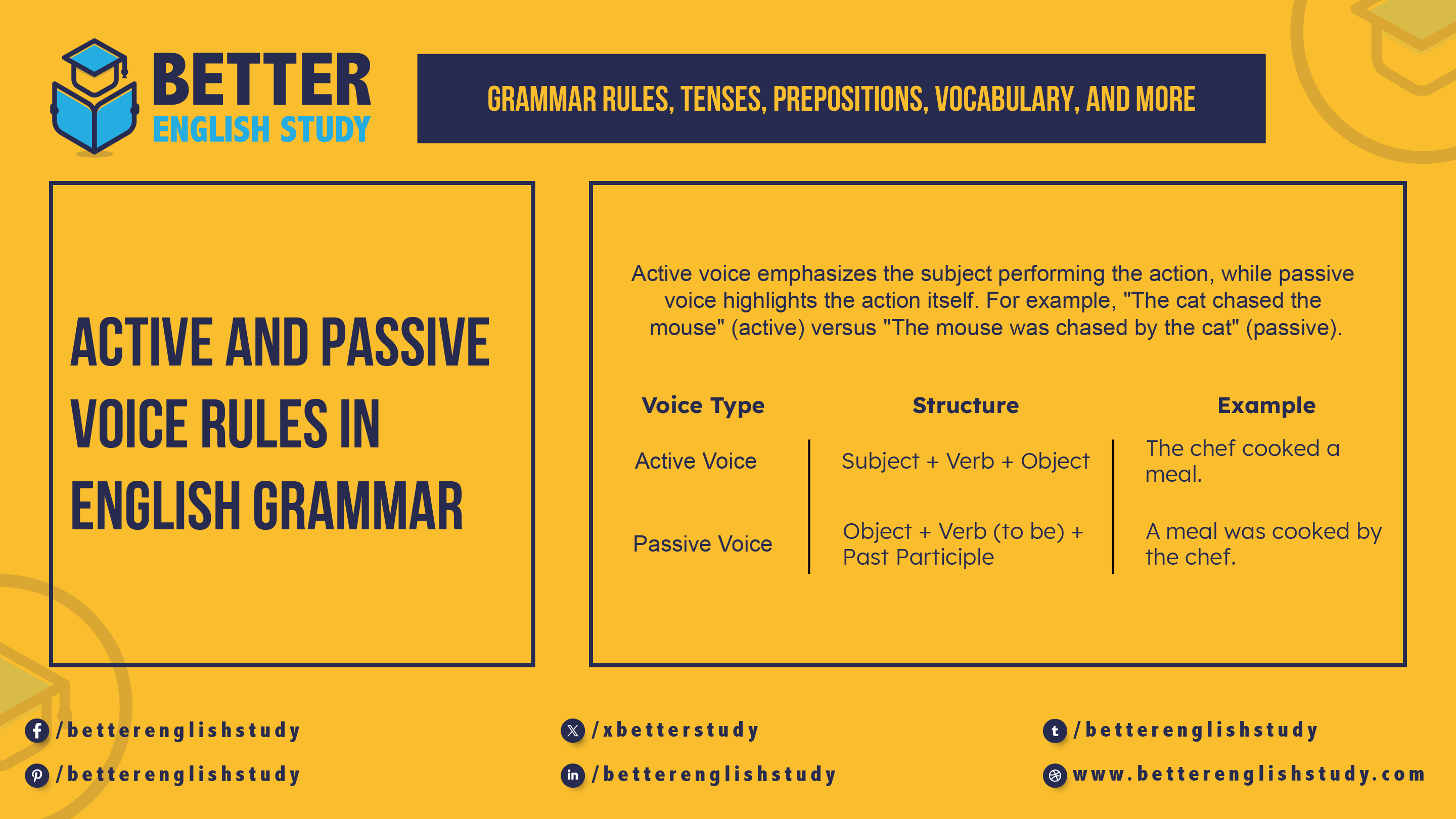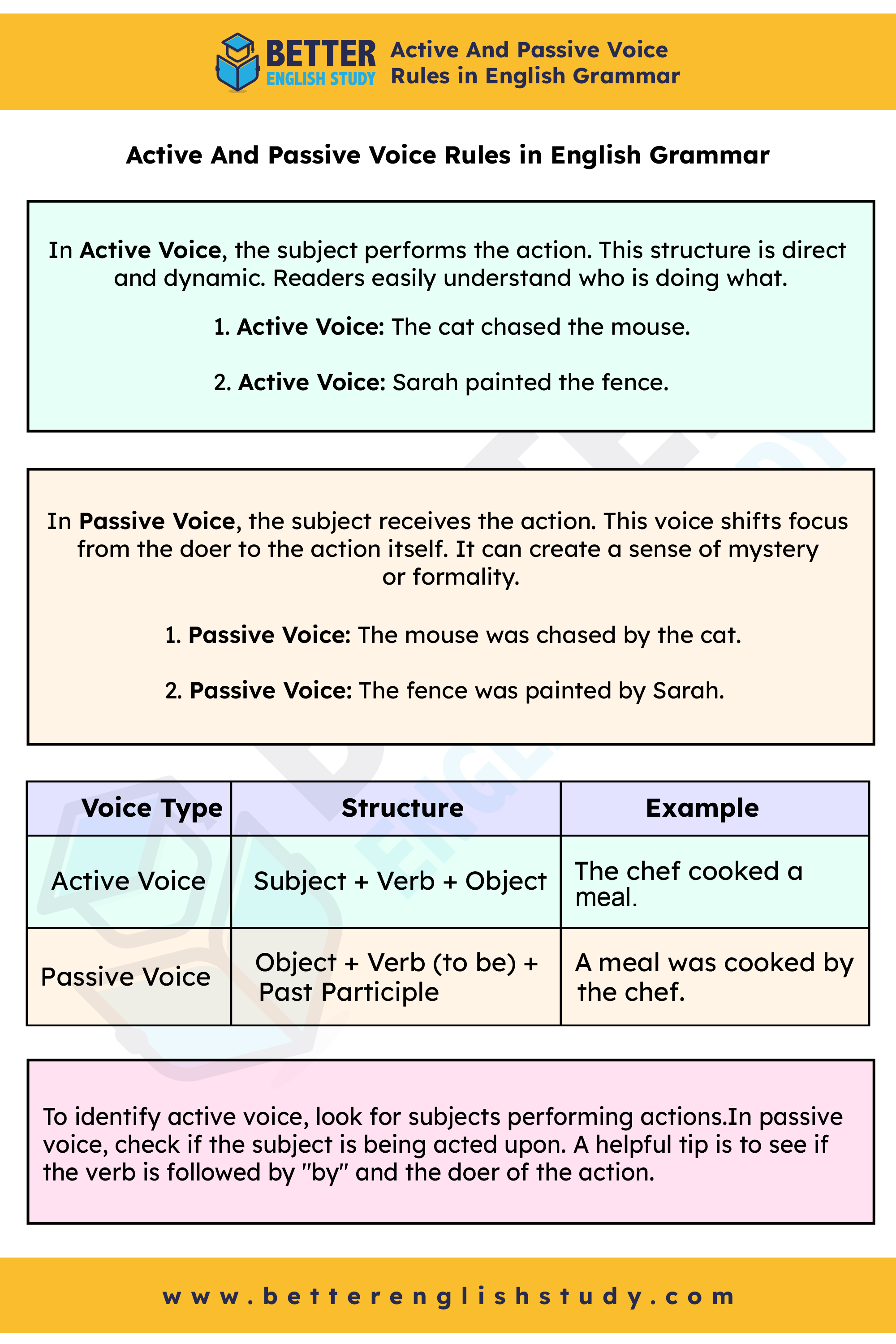
Active voice emphasizes the subject performing the action, while passive voice highlights the action itself. For example, “The cat chased the mouse” (active) versus “The mouse was chased by the cat” (passive).
Understanding the difference between active and passive voice is crucial for effective communication. Active voice creates clarity and directness, making sentences more engaging. Writers often prefer it for its straightforward nature. Conversely, passive voice can add variety to writing but may lead to ambiguity if overused.
The Essence Of Voice In English Grammar
Understanding voice in English grammar is essential. It helps clarify who performs the action. Voice affects the clarity and impact of your writing.
In English, we primarily use two voices: Active Voice and Passive Voice. Each serves a unique purpose. Knowing when to use each can enhance your communication.
Active Voice: A Brief Introduction
In Active Voice, the subject performs the action. This structure is direct and dynamic. Readers easily understand who is doing what.
For example:
- Active Voice: The cat chased the mouse.
- Active Voice: Sarah painted the fence.
In these sentences, the subjects (the cat, Sarah) take action. The message is clear and engaging.
Passive Voice: Unveiling Its Core
In Passive Voice, the subject receives the action. This voice shifts focus from the doer to the action itself. It can create a sense of mystery or formality.
For example:
- Passive Voice: The mouse was chased by the cat.
- Passive Voice: The fence was painted by Sarah.
Here, the action is highlighted.
Use passive voice sparingly. It can make sentences feel weaker. Balance both voices for effective writing.
| Voice Type | Structure | Example |
|---|---|---|
| Active Voice | Subject + Verb + Object | The chef cooked a meal. |
| Passive Voice | Object + Verb (to be) + Past Participle | A meal was cooked by the chef. |
Both voices have their strengths. An active voice is often preferred for clarity. Use passive voice for emphasis or variety.

Active Voice Simplified
The active voice makes sentences clear and direct. In active voice, the subject performs the action. This structure makes writing more engaging. Understanding active voice helps improve communication skills.
Basic Structure And Examples
The basic structure of an active voice sentence is:
- Subject + Verb + Object
Here are some examples:
| Subject | Verb | Object | Active Voice Example |
|---|---|---|---|
| The cat | chased | the mouse | The cat chased the mouse. |
| She | wrote | a letter | She wrote a letter. |
| They | built | a sandcastle | They built a sandcastle. |
When To Use Active Voice
Use active voice for clarity and brevity. Here are some situations:
- In storytelling, to create excitement.
- In instructions, to enhance understanding.
- In essays, to express clear arguments.
The active voice often makes sentences shorter. Readers grasp ideas faster. Use it for effective communication.
Decoding Passive Voice
The passive voice is often misunderstood. In this structure, the subject receives the action instead of performing it. This can shift focus from the doer to the action itself. Understanding the passive voice helps improve your writing skills.
Structure And Transformation
The passive voice follows a specific structure. Here’s how it works:
| Active Voice | Passive Voice |
|---|---|
| The chef cooks the meal. | The meal is cooked by the chef. |
| The teacher explains the lesson. | The lesson is explained by the teacher. |
| The artist painted the mural. | The mural was painted by the artist. |
To transform an active sentence into passive:
- Identify the object of the active sentence.
- Make the object the new subject.
- Use the correct form of the verb “to be.”
- Add the past participle of the main verb.
- Optional: Include the doer with “by.”
Optimal Situations For Passive Use
Using the passive voice can be effective in certain situations:
- When the doer is unknown: “The window was broken.”
- When the doer is irrelevant: “The cake was eaten.”
- To emphasize the action: “The award was won by the student.”
- In formal or academic writing: “The experiment was conducted.”
Passive voice adds variety to your writing. It shifts focus and can make sentences clearer. Use it wisely to enhance your communication skills.
Transitioning Between Voices
Transitioning between active and passive voice can enhance your writing. Understanding how to convert sentences improves clarity and engagement. Here are steps and common pitfalls to help you make these transitions smoothly.
Step-by-step Conversion
- Identify the verb: Find the main verb in the sentence.
- Locate the subject and object: Determine who is doing the action and who is receiving it.
- Change the structure: For active voice, put the subject first. For passive voice, place the object first.
- Add a form of “to be”: Use “is,” “are,” “was,” or “were” before the main verb in passive voice.
- Use the past participle: Ensure the main verb is in its past participle form.
Here’s a quick example:
| Active Voice | Passive Voice |
|---|---|
| The chef cooks the meal. | The meal is cooked by the chef. |
Common Pitfalls In Voice Transformation
- Missing the subject: Always keep the subject clear.
- Incorrect verb forms: Use the correct form of the verb.
- Overuse of passive voice: Avoid making every sentence passive.
- Confusing meanings: Ensure the change does not alter the sentence’s meaning.
Remember to practice these transformations regularly. Mastering voice changes improves your writing skills.
The Role Of Tense In Voice
Tense plays a crucial role in determining how sentences convey actions. It influences whether the subject performs or receives the action. Understanding tense helps clarify meaning in both active and passive voice.
Tense Consistency In Active Voice
In active voice, the subject performs the action. Maintaining tense consistency is vital for clarity. Here are key points for using tense in active voice:
- Present Tense: Describes current actions.
- Past Tense: Indicates completed actions.
- Future Tense: Refers to actions that will happen.
Examples:
| Tense | Example |
|---|---|
| Present | The cat chases the mouse. |
| Past | The dog barked at the stranger. |
| Future | She will bake a cake tomorrow. |
Each example shows the action clearly. Consistent tense helps readers follow the story easily.
Maintaining Tense In Passive Constructions
In passive voice, the subject receives the action. Tense must also be consistent here. Use the following rules:
- Identify the verb tense in the active sentence.
- Change the main verb to the past participle.
- Use the correct form of “to be” based on the tense.
Examples:
| Active Voice | Passive Voice |
|---|---|
| The chef cooks the meal. | The meal is cooked by the chef. |
| The teacher graded the tests. | The tests were graded by the teacher. |
| The team will finish the project. | The project will be finished by the team. |
Notice how the tense remains consistent in both voices. This clarity helps avoid confusion.
Voice And Sentence Complexity
Understanding voice helps simplify sentence complexity. The active voice often makes sentences clearer. Passive voice can add complexity but has its uses. Knowing when to use each voice is crucial for effective communication.
Handling Complex Sentences In Active Voice
Active voice places the subject at the forefront. This makes the sentence direct and lively. Here are some rules for creating complex sentences in active voice:
- Use clear subjects: Identify who is performing the action.
- Combine ideas: Use conjunctions to link thoughts.
- Keep it concise: Avoid overly long sentences.
Examples of complex sentences in active voice:
- The teacher explained the lesson while students took notes.
- My brother plays soccer, and he practices every day.
- The chef prepared the meal before the guests arrived.
Navigating Complexity In Passive Voice
Passive voice shifts focus from the subject to the action. This can create more complex sentences. Here are tips for navigating complexity in passive voice:
- Identify the action: Determine what is being done.
- Use a clear structure: Subject + verb + by + agent.
- Limit unnecessary details: Focus on the main action.
Examples of complex sentences in passive voice:
| Active Voice | Passive Voice |
|---|---|
| The committee approved the new policy. | The new policy was approved by the committee. |
| The scientist conducted the experiment. | The experiment was conducted by the scientist. |
| The manager reviewed the report. | The report was reviewed by the manager. |
Practical Exercises For Mastery
Understanding active and passive voice is crucial in English. Mastery comes with practice. Here are some engaging exercises to enhance your skills.
Active To Passive Conversion Tasks
Convert the following sentences from active to passive voice:
- The cat chased the mouse.
- She reads the book every night.
- They built a beautiful house.
- The teacher explains the lesson.
- We will finish the project by tomorrow.
Answers:
- The mouse was chased by the cat.
- The book is read by her every night.
- A beautiful house was built by them.
- The lesson is explained by the teacher.
- The project will be finished by us by tomorrow.
Passive To Active Reversal Challenges
Now, convert these sentences from passive to active voice:
- The cake was eaten by the children.
- The song was sung by the choir.
- The homework was completed by Sarah.
- The game was won by the team.
- The movie was directed by the famous filmmaker.
Answers:
- The children ate the cake.
- The choir sang the song.
- Sarah completed the homework.
- The team won the game.
- The famous filmmaker directed the movie.
Practice these exercises regularly. They will help you gain confidence. Understanding the rules of active and passive voice will improve your writing skills.
Common Mistakes And How To Avoid Them
Understanding the rules of active and passive voice is important. Many people make common mistakes in their writing. This section highlights these errors and offers tips to avoid them.
Frequent Errors In Active Voice
Active voice is straightforward. The subject performs the action. Here are some common mistakes:
- Unclear subjects: Sentences may lack a clear subject.
- Overly complex sentences: Long sentences confuse readers.
- Misplaced modifiers: Modifiers can change the meaning.
Here are examples of these mistakes:
| Error Type | Incorrect Sentence | Correct Sentence |
|---|---|---|
| Unclear subjects | The book was read by her. | She read the book. |
| Overly complex | Running quickly to the store, the rain started. | The rain started while I ran to the store. |
| Misplaced modifiers | The dog barked loudly at the man in the hat. | The man in the hat barked loudly at the dog. |
Typical Passive Voice Missteps
Passive voice can be useful. It emphasizes the action, not the subject. Still, it has its pitfalls:
- Weak verbs: Using forms of “to be” weakens the sentence.
- Overusing passive voice: It can make writing dull.
- Ambiguous agents: Not stating who performed the action can confuse readers.
Here are examples of these mistakes:
| Error Type | Incorrect Sentence | Correct Sentence |
|---|---|---|
| Weak verbs | The cake was baked by the chef. | The chef baked the cake. |
| Overusing passive | The project was completed by the team. | The team completed the project. |
| Ambiguous agents | The book was stolen. | A thief stole the book. |
By avoiding these common mistakes, your writing can improve. Use active voice for clarity. Reserve passive voice for emphasis when needed.
Frequently Asked Questions
What Is Active Voice In English Grammar?
Active voice occurs when the subject performs the action of the verb. For example, “The cat chased the mouse. ” In this sentence, “the cat” is the subject actively performing the action. Using active voice makes sentences clearer and more engaging for readers.
What Is Passive Voice In English Grammar?
Passive voice is when the subject receives the action of the verb. For example, “The mouse was chased by the cat. ” Here, “the mouse” is the subject but does not perform the action. Passive voice can make writing less direct and sometimes more formal.
How Do I Identify Active And Passive Voice?
To identify active voice, look for subjects performing actions. In passive voice, check if the subject is being acted upon. A helpful tip is to see if the verb is followed by “by” and the doer of the action. This distinction can enhance your grammar skills.
When Should I Use Active Or Passive Voice?
Use active voice for clarity and directness in writing. It engages the reader better. Passive voice is useful when the doer is unknown or irrelevant. Consider the context and purpose to decide which voice fits your writing best.
Conclusion
Understanding active and passive voice is essential for clear communication. Mastering these rules enhances your writing skills. Use active voice for directness and passive voice for emphasis when needed. With practice, you can easily switch between the two. Keep these examples in mind, and your grammar will improve significantly.
